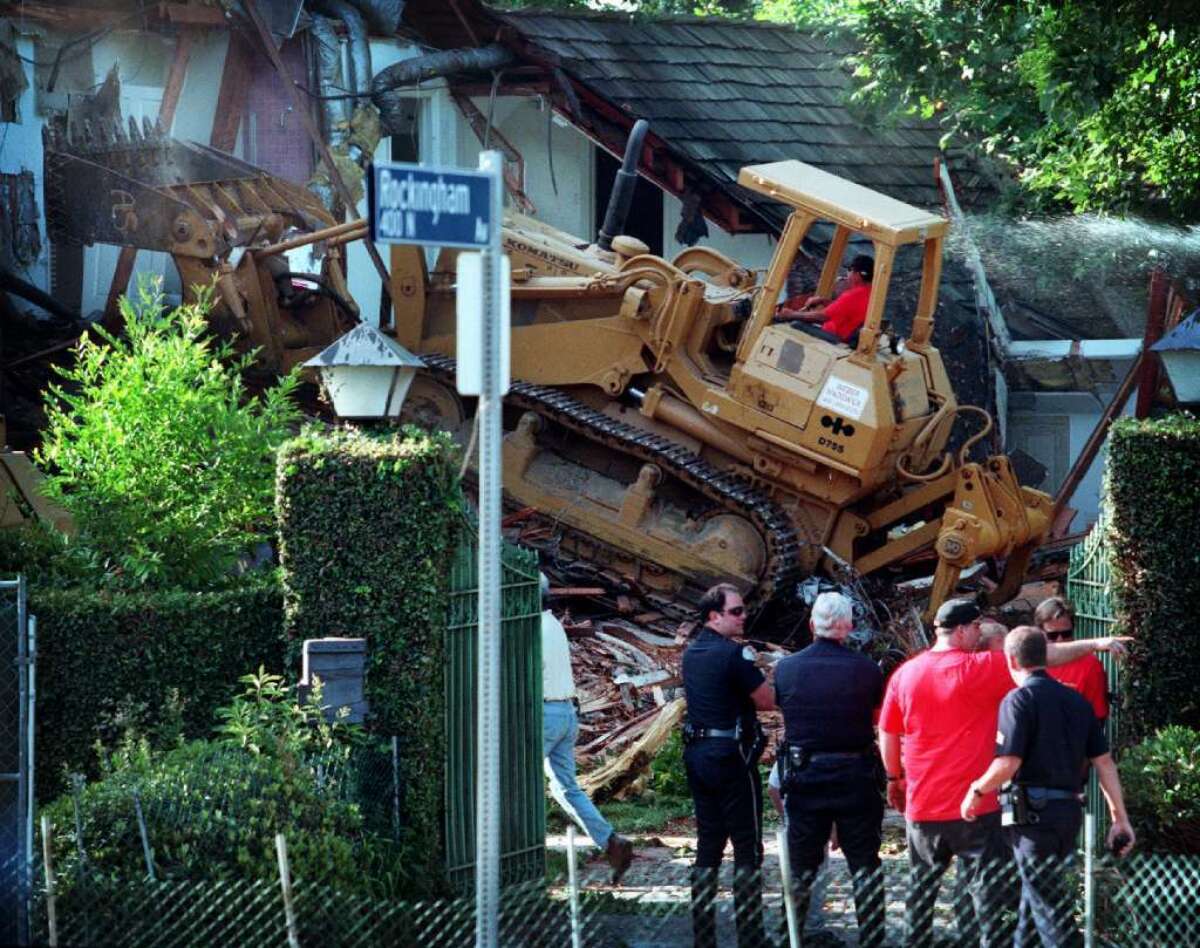L.A. Stories: The city took a key role in the re-creation of the O.J. Simpson trial

- Share via
Yes, Randy Newman, from the South Bay to the Valley, from the Westside to the Eastside, everybody loves Los Angeles these days. Television, especially. In this recurring feature, L.A. Stories, we look at what TV is saying about the City of Angels in 2016.
Screenwriters Scott Alexander and Larry Karaszewski weren’t lacking characters to include in their sprawling limited series “The People v. O.J. Simpson: American Crime Story.” Consider, with Simpson, his defense team, prosecutors Marcia Clark and Chris Darden, Judge Lance Ito and, yes, even socialite Faye Resnick, the woman who gave us the “Brentwood hello,” there was a surplus of stories to tell.
But, in that narrative thicket, the writers wanted to make sure one character didn’t get lost.
“This is such an L.A. story,” Alexander says. “It was very important to give Los Angeles a prominent role.”
“The People v. O.J.” hops from Brentwood and Beverly Hills to the Valley and downtown, using the city’s demarcation to define its characters and the trouble they have understanding one another.
Most of the infamous sites involved in the 1994 double murder have been razed, closed or changed. Simpson’s Tudor mansion was bulldozed long ago. Nicole Simpson’s South Bundy Drive condo was sold and extensively remodeled, making it unrecognizable. Mezzaluna, the Brentwood restaurant where Nicole dined on the last night of her life and where Ron Goldman worked as a waiter, closed in 1997.
But there were still plenty of spots and props that helped the “O.J.” team tell the story. Here are a few.
Mr. Chow, 344 N. Camden Drive, Beverly Hills
We first meet John Travolta’s canny defense attorney Robert Shapiro in this elegant Beverly Hills institution, a place where power players come to be seen as much as to eat its Chinese cuisine.
“We originally set this in Spago, but the old Spago is no longer there,” Alexander says. “Mr. Chow is and looks exactly the same. And the people there still float above their worlds, perfect for introducing Shapiro.”
Ocean and Colorado avenues, Santa Monica. In the opening episode, we see America’s most famous houseguest, Kato Kaelin, jogging along this pristine stretch of coastline near the Santa Monica Pier. The scene exists for no other reason, the writers say, than to showcase the allure of Los Angeles.
“It’s this beautiful stretch of grass right along a street with the ocean behind it,” Alexander says. “It’s fantastic. It says L.A. in a way no other image can.”
“And everyone in that scene is just ridiculously good-looking,” Karaszewski adds. “It’s all about the aspirational allure of the city.”
Robert Kardashian’s home, 16254 Mandalay Drive, Encino
The massive Valley property, described as “garish” and a “Tehran bordello” by “The Run of His Life: The People v. O.J. Simpson” author Jeffrey Toobin, still looks exactly like it did in 1994 when Kardashian leased it and, shortly afterward, let Simpson stay there to keep out of the media spotlight.
“Even the kitchen is stuck in time,” Karaszewski says, “and that’s the room that always spells trouble on a period shoot.”
Marcia Clark’s home, 3314 Club Drive, Cheviot Hills
This modest ranch house stood in for Clark’s Valley location, its ordinariness providing a stark contrast to the swanky homes of defense attorneys Shapiro and Johnnie Cochran.
“We wanted to show the resources the defense team had,” Karaszewski says. “So any time you had a set associated with the defense, it was soft lighting and carpeting and with the prosecution, it’s fluorescents and linoleum. One look at Marcia’s house and you see it needs a paint job, which she probably can’t afford.”
Second Baptist Church, 2412 Griffith Ave., Los Angeles
The miniseries used Cochran’s church, found on the National Register of Historic Places, for a scene in which the attorney asks his pastor, the Rev. William Epps, for prayer support before the trial. Epps played himself.
“He and Larry King are the only two people who played themselves,” Alexander notes.
O.J. Simpson statue, Flavor Flav’s possession, location unknown
The miniseries ends with Simpson (Cuba Gooding Jr.) standing in his backyard, gazing up at a life-size statue made in his likeness, realizing, perhaps for the first time, that he is no longer that man.
The producers went on a desperate hunt for the real statue before the shoot, but couldn’t find it. Then they came across a tweet from musician Flavor Flav, a member of Public Enemy, saying he had it. Too late, though. They used a duplicate.
“But it could not have found a more perfect home,” Alexander says.
MORE:
Robert Shapiro reveals what O.J. Simpson said after his court verdict was read
Robert Kardashian: Keeping up with the man who stood by O.J. Simpson
Prison officials post photo of a smiling O.J. Simpson
‘The People v. OJ Simpson’: Cuba Gooding Jr. says ‘there’s so much that trial shed a light on’
@glennwhipp
More to Read
From the Oscars to the Emmys.
Get the Envelope newsletter for exclusive awards season coverage, behind-the-scenes stories from the Envelope podcast and columnist Glenn Whipp’s must-read analysis.
You may occasionally receive promotional content from the Los Angeles Times.








